Mexico has long been a hub of artistic innovation, producing some of the most influential and celebrated artists in history. From the bold, surreal self-portraits of Frida Kahlo to the monumental murals of Diego Rivera, Mexican artists have left an indelible mark on the world of art. Rooted in indigenous traditions, colonial influences, and revolutionary ideals, Mexican art is known for its vivid colors, powerful symbolism, and deep connection to history and social justice.
Let’s explore some of the most famous Mexican artists and their unique styles, cultural contributions, and lasting impact on the art world. You might just find an inspiration you want to frame on your wall.
14 Mexican Artists You Should Learn About
- José Guadalupe Posada (1852–1913)
- David Alfaro Siqueiros (1896–1974)
- José Clemente Orozco (1883–1949)
- Rufino Tamayo (1899–1991)
- Diego Rivera (1886–1957)
- Miguel Covarrubias (1904–1957)
- Abraham Ángel (1905–1924)
- Manuel Álvarez Bravo (1902–2002)
- Lola Álvarez Bravo (1907–1993)
- Frida Kahlo (1907–1954)
- Jamex de la Torre (1960–present)
- Einar de la Torre (1963–present)
- Pedro Linares (1906–1992)
- Narsiso Martinez (1977–present)
José Guadalupe Posada: Master of Mexican Caricature
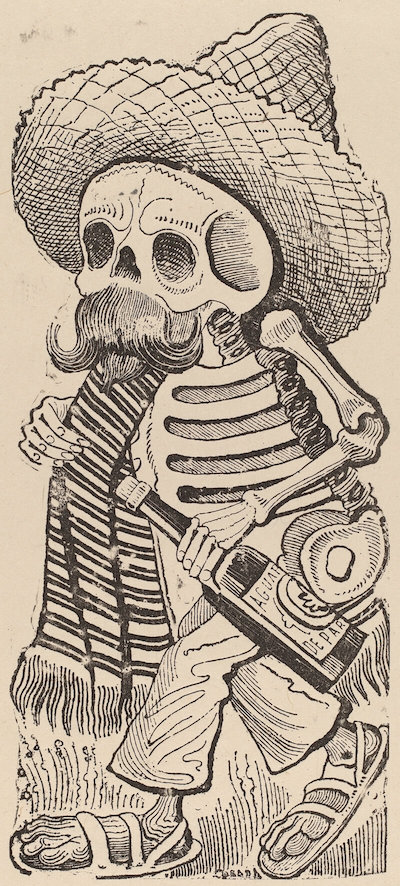
Posada’s Calavera Maderista (circa 1910)
José Guadalupe Posada is often hailed as a master of Mexican caricature. Born in Aguascalientes, Mexico, Pasada carved a niche for himself in the art word with his iconic calaveras (skeletons).
As a caricaturist, Posada’s works weren’t just about the festive Día de los Muertos; they were a form of political satire, highlighting societal issues through visual storytelling. He worked during a period of political repression, using his art to critique death, politics, and social justice.
His impactful images made his topics accessible during a period of low adult literacy rates, ensuring his messages reached a wide audience. Despite limited recognition in his lifetime, Posada’s legacy in Mexican art history remains influential, inspiring countless artists and cartoonists across Latin America to explore similar themes in their work.
Iconic Works by Posada
- La Calavera Catrina (The Elegant Skull) – His most famous skeleton illustration, later popularized in a fresco by Diego Rivera.
- Calaveras del Montón – A satirical depiction of skulls representing Mexican society.
- El Jarabe en Ultratumba – A humorous dance of skeletons, blending folklore with social critique.
- Don Quijote en Calavera – A skeletal version of Cervantes’s famous literary character.
David Alfaro Siqueiros: The Innovator of Murals
David Alfaro Siqueiros is a cornerstone of the Mexican muralist movement who transformed the art world with his innovative techniques and fervent political messages.
His politically charged artworks, like Echo of a Scream and Death to the Invader, capture themes of revolution and social justice. His use of industrial materials and airbrushes adds depth and dynamism, setting his murals apart.
Siqueiros’s works are renowned for their emotional intensity, offering powerful social commentary on the human condition. Beyond painting, Siqueiros influenced modernist ideas in Latin America and established an art school in New York, furthering his impact.
Iconic Works by Siqueiros
- Echo of a Scream – An image of a crying child amidst war destruction.
- Death to the Invader – A mural about imperialism.
- Portrait of the Bourgeoisie – A surrealist-style mural.
- March of Humanity – One of the largest murals in the world, exploring human progress.
José Clemente Orozco: The Revolutionary Muralist
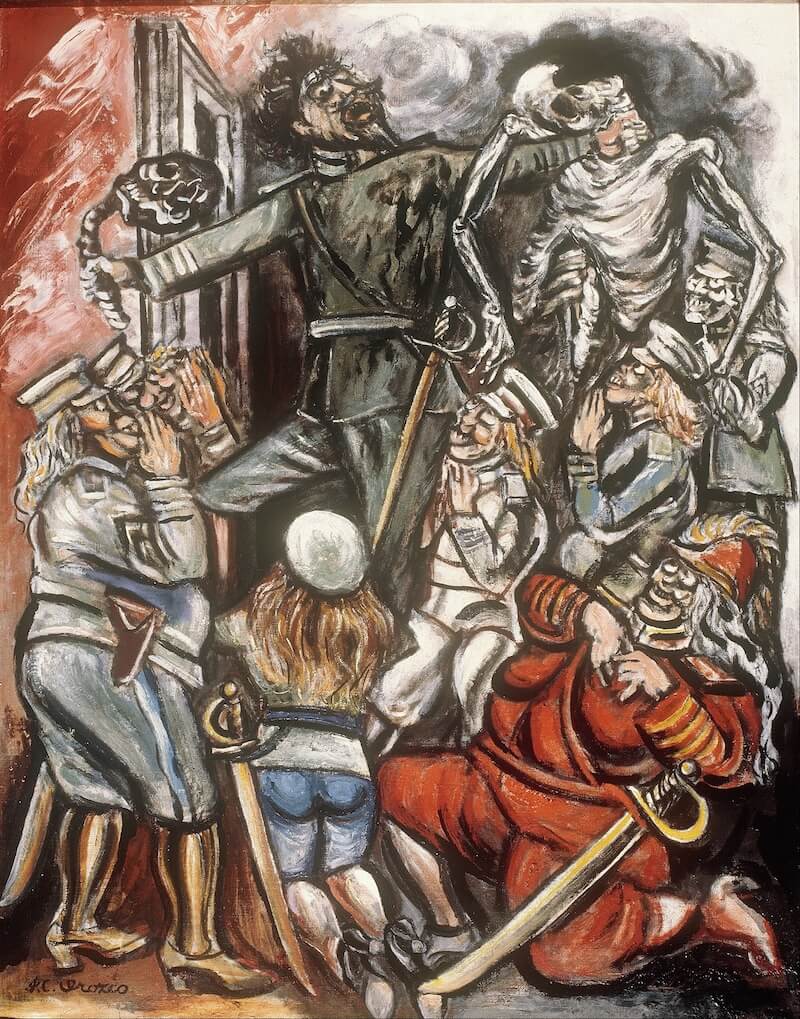
Orozco’s The Demagogue (1946)
As you explore the rich fabric of Mexican art, the legacy of José Clemente Orozco stands out with its intense and emotive power.
As a prominent Mexican muralist, Orozco’s dramatic artwork dives deep into the aftermath of the Mexican Revolution. His murals, such as Prometheus, Catharsis, and Man of Fire, convey themes of human suffering and emotional intensity.
Orozco embraced political art, believing that politics and art were inseparable. His murals in the Hospicio Cabañas highlight his mastery of using light and shade to create powerful visual contrast.
Alongside Rivera and Siqueiros, Orozco defined Mexican art and left a profound impact on the global stage.
Iconic Works by Orozco
- Prometheus – A mural at Pomona College symbolizing human enlightenment and struggle.
- Man of Fire (Hombre en Llamas) – A fresco at Hospicio Cabañas, considered his masterpiece.
- The Epic of American Civilization – A series of murals at Dartmouth College, depicting indigenous and colonial history.
- Catharsis – A piece created during Orozco’s seven-year residency in the US.
Rufino Tamayo: Bridging Tradition and Modernism
While exploring the landscape of Mexican art, Rufino Tamayo stands out for his ability to blend traditional elements with modernist styles. This harmony birthed a unique visual language.
Incorporating the vibrant colors of Mexico and abstract forms, Tamayo’s work celebrated Mexican identity while reflecting cultural heritage and contemporary influences. Notable pieces like Woman in Gray and Watermelons exemplify his mastery of these techniques.
Unlike many contemporary artists, he steered clear of overt political messages, focusing instead on universal themes and human experience. His innovative Mixografia technique added rich texture to his prints, enhancing his artistry.
Tamayo also contributed greatly to Mexican culture by helping establish the Museo de Arte Prehispánico de México, underscoring his commitment to preserving and promoting Mexican art and culture.
Iconic Works by Tamayo
- Women of Tehuantepec – A striking portrayal of indigenous Mexican women.
- Watermelons – A vibrant, abstract still life of Mexico’s beloved fruit.
- Animals – A dynamic piece showcasing his use of color and form.
- Duality – A modernist depiction of Mexican mythology and cosmic balance.
Diego Rivera: The Master of Mexican Muralism
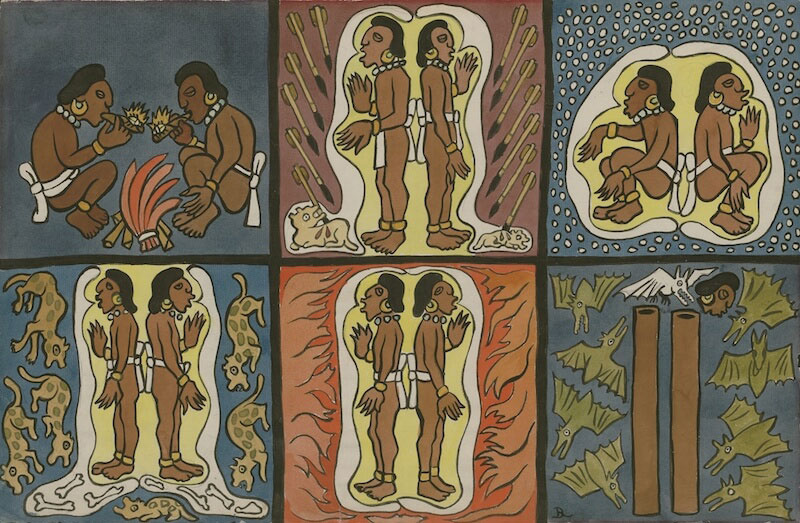
Rivera’s Trials of the Hero-Twins (1931)
Diego Rivera stands as a towering figure in Mexican muralism, and his artistry transformed public spaces with his large-scale works that depicted Mexican history and indigenous heritage. His murals, such as Man at the Crossroads and The History of Mexico, are renowned for their bold compositions and social realism, capturing the complexities of post-revolutionary Mexico.
His detailed frescoes, painted on the walls of government buildings, universities, and public spaces, made art accessible to the masses, reinforcing the idea that art should be for everyone, not just the elite.
While often recognized for his tumultuous relationship with Frida Kahlo, Rivera’s contributions to Mexican art stand on their own. His influence extended beyond Mexico, leaving a mark on American and European modernist movements and solidifying his status as one of the most important muralists of the 20th century.
Iconic Works by Rivera
- Man at the Crossroads – This piece was originally created at Rockefeller Place in NYC, but was later plastered over.
- The History of Mexico – A sweeping mural covering Mexican history and revolution.
- Detroit Industry Murals – A seven-panel piece portraying concepts related to the Ford Motor Company and automotive production.
- Dream of a Sunday Afternoon in Alameda Park – A vibrant scene featuring key figures from Mexican history.
Miguel Covarrubias: The Caricature Genius
Miguel Covarrubias was a multifaceted artist born in Mexico City in 1904. He captivated audiences with his sharp caricatures that graced the pages of Vanity Fair and The New Yorker.
His artistic style featured a blend of pre-Columbian art and modernist aesthetics, reflecting the rich fabric of the Mexican art scene. Covarrubias didn’t just stop at caricatures; he was also a muralist and art historian.
His passion for Mexican folklore and traditions shone through his work, leaving a lasting legacy. He enriched Mexico’s cultural heritage with his extensive collection of pre-Columbian art, which he generously donated to the National Museum of Anthropology.
Covarrubias’s influence persists, inspiring artists and preserving a crucial connection to Mexico’s artistic roots.
Iconic Works by Covarrubias
- Caricatures of Jazz Age Celebrities – Illustrations for Vanity Fair and The New Yorker.
- Pageant of the Pacific – A mural series depicting indigenous cultures of the Pacific.
- Sketches of Mexican Folklore – Illustrations celebrating Mexican traditions and customs.
- Bali Mural – A vivid portrayal of Balinese culture, blending anthropology and art.
Abraham Ángel: A Short-Lived Artistic Legend
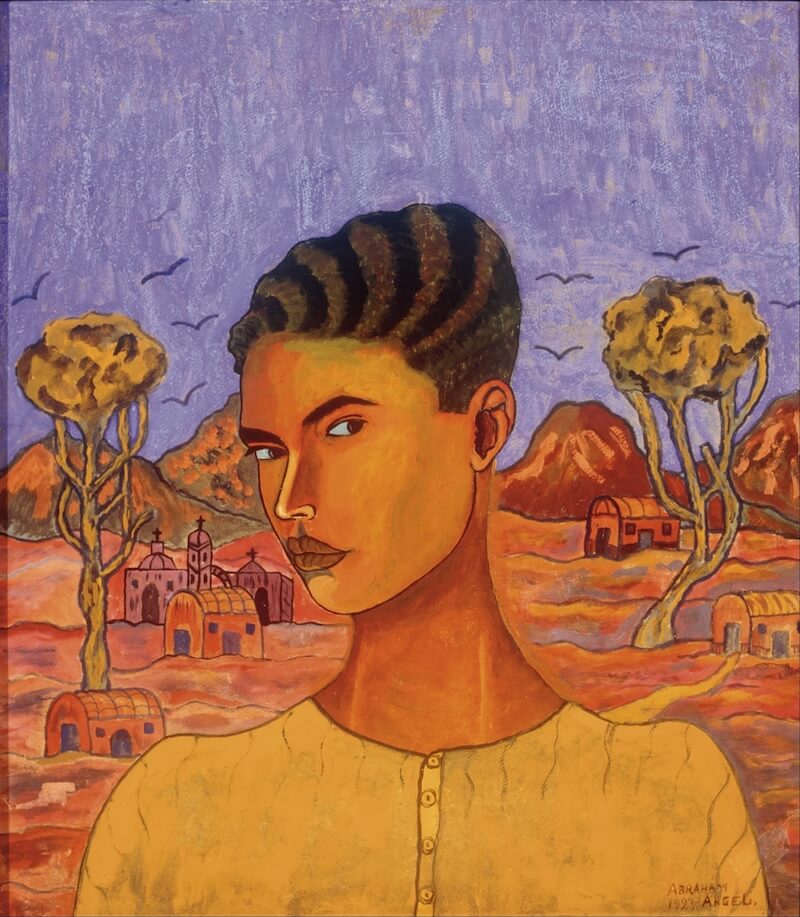
Ángel’s Self-Portrait (1923)
Abraham Ángel was a famous Mexican artist whose brief yet profound presence in the art world left an indelible mark. Born in 1905, Ángel’s paintings vividly captured the cultural changes in Mexico City during the 1920s.
Despite his short life, his use of vibrant colors and dynamic compositions reflected modernist influences intertwined with traditional Mexican themes. Diego Rivera, a titan in Mexican art history, recognized Ángel’s talent, praising his unique vision.
Though Ángel died at just 19, his 24 paintings reveal a deep engagement with the evolving society, symbolizing the emerging potential of post-revolutionary Mexican artists.
Iconic Works by Ángel
- Self-Portrait – A youthful and expressive image of the artist.
- Street in Mexico City – Capturing the energy and color of urban life.
- The Blue Dress – A vibrant, modernist portrait with striking use of color.
- Man with Hat – An expressive and unconventional take on Mexican identity.
Manuel and Lola Álvarez Bravo: Pioneers of Mexican Photography
In exploring the world of Mexican photography, the pioneering contributions of Manuel and Lola Álvarez Bravo stand out.
Manuel Álvarez Bravo stands out as a significant figure, capturing Mexican culture and identity through his lens. His photography investigates social issues, weaving surrealism with traditional themes and elevating the art form in Mexico.
Lola Álvarez Bravo, a prominent photographer in her own right, is celebrated for her portraits and social commentary, depicting the lives of ordinary Mexicans.
Together, they’ve played vital roles in the Mexican art scene, establishing photography as a respected medium. Their work has gained international acclaim, with exhibits in prestigious galleries, influencing future generations and showcasing their impact on the evolution of Mexican photography.
Iconic Works by the Bravos
Manuel Álvarez Bravo
- The Daydreaming Boy – A poetic and melancholic image of childhood.
- The Crouched Ones – A surrealist composition exploring form and emotion.
- Optical Parable – A masterful interplay of light, shadow, and reflection.
- Burial in the Isthmus – A powerful scene of a traditional funeral.
Lola Álvarez Bravo
- Portrait of Frida Kahlo – A famous image capturing Kahlo’s strength and beauty.
- The Dream of the Poor – A black-and-white image of a child sleeping.
- The Teachers’ Strike – A compelling political photo of protests in Mexico.
- Atentado a los Artesanos – A dynamic portrayal of artisans at work.
Frida Kahlo: The Icon of Self-Expression
Frida Kahlo is one of Mexico’s most celebrated artists. Her deeply personal and surreal self-portraits have left an indelible mark on the art world. Known for her raw emotional expression, Kahlo’s work explores themes of identity, pain, and resilience, often reflecting her struggles with physical ailments and personal hardships.
Her paintings, such as The Two Fridas and Self-Portrait with Thorn Necklace and Hummingbird, blend Mexican folk art, surrealism, and symbolism—a combination that made her one of the most recognizable figures in art history. Kahlo’s signature style incorporates bright colors, indigenous motifs, and dreamlike imagery, setting her apart as a pioneer of autobiographical and feminist art.
Kahlo’s image is characterized by traditional Tehuana dresses, bold jewelry, and a distinctive unibrow— with all becoming a symbol of cultural pride and defiance. Though she gained more recognition posthumously, today, her legacy extends beyond painting, influencing fashion, literature, and feminist movements worldwide.
Iconic Works by Kahlo
- The Two Fridas – A deeply personal double self-portrait exploring identity.
- Self-Portrait with Thorn Necklace and Hummingbird – Symbolizing pain and resilience.
- The Broken Column – A haunting depiction of her physical suffering.
- Henry Ford Hospital – A surreal and emotional exploration of her experience in the hospital.
Einar and Jamex de la Torre: Masters of Mixed Media
Following in the innovative footsteps of artists like Miguel Covarrubias, Einar and Jamex de la Torre bring a vibrant energy to the Mexican art scene with their masterful mixed media creations.
Born in Guadalajara, the brothers are renowned for their blown glass sculptures and installation art that seamlessly blend Mexican culture with contemporary art.
Through large-scale installations, they invite you to explore complex social commentary, often infused with humor and irony. Their works challenge your perception of space, encouraging interaction and reflection.
Exhibited at prestigious venues like the Museum of Contemporary Art San Diego, the duo’s art promotes glass as a serious medium.
They’ve received multiple awards throughout their lives and solidified their significant impact on the contemporary art scene.
Iconic Works by the de la Torres
- Colonial Atmosphere – A mixed-media critique of colonial history.
- The Border Again – A blown-glass sculpture exploring immigration themes.
- La Reconquista – A striking installation on Mexican identity and history.
- El Grito – A vibrant, surrealist take on Mexican independence.
Pedro Linares: Creator of Alebrijes
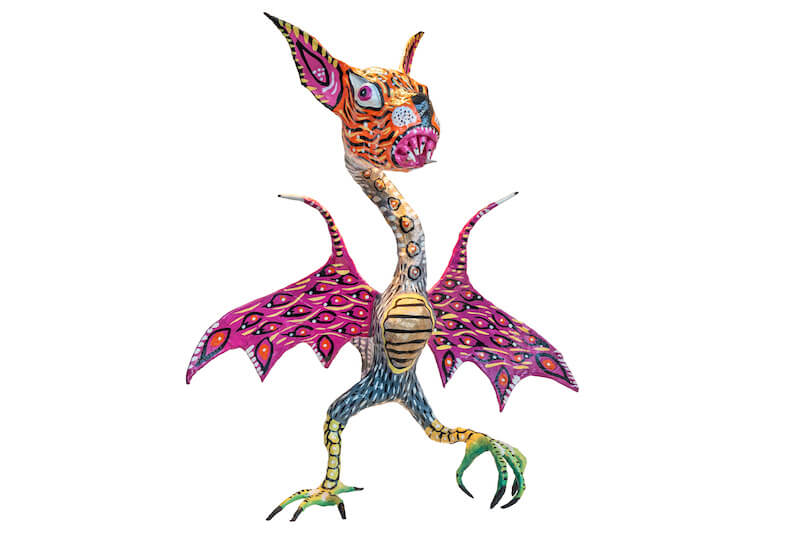
Pedro Linares, a visionary Mexican artisan born in 1906, gifted the world with the enchanting creations known as alebrijes.
These fantastical creatures, crafted first from papier-mâché and later by others with wood, burst with vibrant colors and intricate patterns. Linares’s journey with alebrijes began in the 1930s, inspired by a dream where he encountered a landscape filled with hybrid animals.
This unique art form soon gained international acclaim, becoming a beloved part of Mexican folk art and contemporary Mexican culture. In recognition of his significant contributions, Linares received the National Prize for Arts and Sciences in 1990.
His enchanting alebrijes have inspired many, even influencing the animated movie Coco, which celebrates Mexican traditions.
Iconic Works by Linares
- Alebrijes Series – His signature collection of fantastical, dreamlike creatures.
- Serpent Alebrije – A striking fusion of Mexican mythology and surrealism.
- Jaguar Alebrije – A vibrant representation of a powerful, mystical animal.
- Dragon Alebrije – A complex, multicolored hybrid of various animals.
The Enduring Influence of Mexican Art
The legacy of Mexico’s most famous artists is a mosaic of talent that continues to inspire generations of artists and other creatives around the world. Their artistry, whether found in museums, public spaces, or private collections, continues to serve as powerful reflections of Mexican history and culture. Today, their works shape the global art scene and leave behind a rich cultural heritage that remains relevant and inspirational. Hang a canvas featuring reproductions of their greatest works and let their creativity inspire your daily endeavors.




